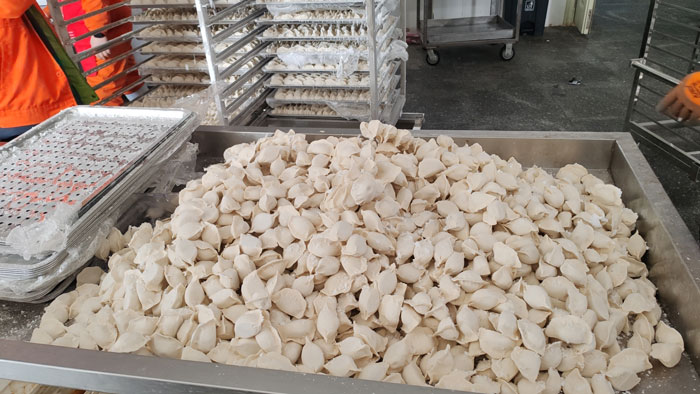For artisan bakeries, fine-dining central kitchens, niche ingredient providers, or food R&D labs, working with small but premium batches is routine. Conventional freezing systems often fail to meet both the speed and quality expectations of these users. In this landscape, liquid nitrogen freezers emerge as a superior alternative. This article explores the real freezing speed for small quantities of food using liquid nitrogen and why it matters.
I. Comparing Freezing Speeds: Traditional vs. Liquid Nitrogen
To evaluate liquid nitrogen, it’s useful to contrast it with standard freezing methods.
1. Traditional Freezing (Conventional Freezer Units):
Speed: Significantly slower. Dropping the core temperature of food to -18°C usually takes hours, sometimes an entire day.
Mechanism: Cold air circulates around the product, gradually conducting cold from the exterior inward—a sluggish form of heat transfer.
Impact: During the extended process, water molecules in the cells crystallize into large, sharp-edged ice structures. These rupture the cellular walls, so when thawed, the food loses vital juices, becoming dry or mushy. Meat turns tough, and fruits lose firmness.
2. Liquid Nitrogen Freezing (Cryogenic Ultra-Fast Freezing):
Speed: Exceptionally quick. For individual small items—berries, dumplings, shrimp, or steaks—core freezing to -18°C can occur within minutes. Very thin items such as herb leaves or seafood slices may freeze in mere seconds.
Mechanism: With a boiling point of -196°C, liquid nitrogen vaporizes explosively on contact with food, absorbing immense energy. A dense, super-cold nitrogen vapor cloud envelops each item, delivering full-contact, rapid heat extraction.
Key Advantage: The short freezing time prevents formation of large crystals. Instead, micro-crystals form, which do not compromise cellular structures, thus protecting texture and moisture.
II. How Does Liquid Nitrogen Freezing Work?
Although the technology sounds advanced, the principles are straightforward.
Supply System: Liquid nitrogen stored in an external tank is piped into the freezer chamber through insulated lines.
Spray Mechanism: Specialized nozzles atomize nitrogen into fine droplets and disperse them evenly over the food.
Rapid Heat Transfer: Upon hitting warmer surfaces, nitrogen vaporizes instantly, absorbing heat at high efficiency. The heavier cold gas fills the chamber, creating an ultra-low temperature atmosphere.
Smart Control: Modern systems use sensors to track product temperature, halting the nitrogen flow once the target is reached, ensuring uniform freezing while saving nitrogen.
III. Factors That Influence Freezing Speed
A few operational and material variables dictate how fast small batches freeze:
Thickness of Products: The single most important factor. Smaller portions or sliced items freeze faster than bulky cuts. For example, five thin meat slices freeze far quicker than one thick steak of equal weight.
Initial Temperature: Pre-chilled foods (+4°C) require 20–30% less freezing time and nitrogen compared to room-temperature products.
Loading Method: Batches should be laid out evenly rather than stacked. Over-piling prevents uniform freezing—outer layers harden while the center lags.
Food Composition: High-moisture foods (fish, vegetables, fruits) freeze faster. Fat-rich or sugary products (cakes, sauces) take slightly longer due to lower freezing points.
Equipment Design:
Nozzles: Better atomization improves efficiency.
Insulation: Superior insulation reduces nitrogen loss.
Automation: Programmable settings ensure optimal freezing curves for different products.

IV. Why Speed Matters: Benefits for Small-Batch Operators
Preservation of Quality:
Texture and Moisture: Steaks remain juicy, and delicate berries retain firmness.
Nutritional and Flavor Retention: Aromas and nutrients are locked in at the moment of freezing.
Shape Integrity: Decorative elements like edible flowers or dessert garnishes keep their original form.
Business Advantages:
Seasonal Extension: Niche farms can store rare crops or seafood for off-season markets.
Product Differentiation: Labeling products as “flash-frozen with liquid nitrogen” enhances perceived value.
Reduced Waste: Immediate freezing of unsold fresh ingredients reduces spoilage, saving costs.
V. Choosing the Right Freezer for Small-Batch Use
When selecting a liquid nitrogen freezer, consider:
Capacity Requirements: Match the machine size to your daily load. Small Cabinet type or tunnel type are available.
Nitrogen Efficiency: Compare nitrogen consumption per kilogram of product, as it impacts long-term cost.
Safety Systems: Look for features like oxygen sensors and reliable ventilation.
Supplier Support: Stable nitrogen supply and strong after-sales service ensure continuous operations.
VI. Common Questions
Q: Is liquid nitrogen freezing safe for food?
A: Yes. Nitrogen is naturally abundant in air, inert and harmless. It leaves no chemical residue—only temperature change. Operators must, however, avoid direct skin contact with liquid nitrogen.Q: Isn’t it expensive for small runs?
A: While nitrogen itself has a cost, the broader calculation includes improved quality, higher product pricing, lower waste, and faster turnaround. For premium goods, ROI is usually positive.Q: Can all foods be frozen this way?
A: Most high-value items benefit greatly. Leafy greens such as lettuce may not regain fresh texture after thawing, but they remain suitable for cooked applications.
Liquid nitrogen transforms freezing from a multi-hour process into minutes or even seconds. Beyond speed, it safeguards quality, enhances shelf life, and unlocks new commercial opportunities. For small-batch producers seeking excellence, adopting cryogenic freezing is not optional—it is becoming a defining factor of competitiveness.
